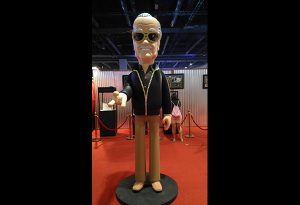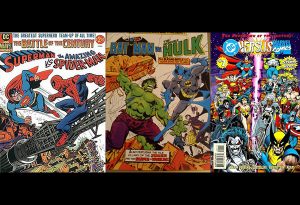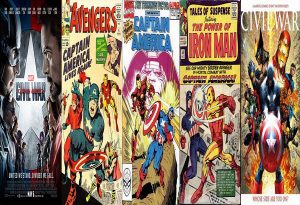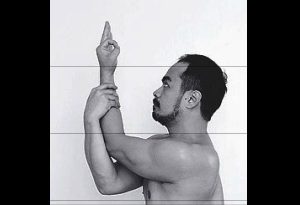Mark Millar is a Wanted Man.
He is wanted for making Captain America and Iron Man go to war. He is wanted for creating a mass-murdering villain named Nemesis. He is wanted for turning 10-year-old girls into assassins.
Scottish scribe Mark Millar has written almost all of the iconic characters in Marvel Comics including the X-Men, Fantastic Four and Spider-Man. His work on the Ultimates, a more realistic take on the Avengers, served as a template for the billion-dollar blockbuster of the same name. He has also written his own creator-owned comics included Wanted and Kick-Ass, which have both been adapted into movies. Two of his other works Chosen and War Heroes, have been optioned by Sony Pictures, while his latest titles Superior and Supercrooks are already in various stages of adaptation as well.
Not bad from a kilt-wearing lad from Scotland, oy? And after Mark ran a promotional contest where he offered to visit and sign comic books in the store that purchased the most number of copies of his newest book Supercrooks#1, National Book Store won the opportunity to bring over Mark to the country where he had the rare opportunity to share the stage with his Philippine-based Supercrooks collaborators, artists Leinil Yu and inker Gerry Alanguilan.
Close Ad X
With the help on a Scottish to English translator, I had the opportunity to interview Mark Millar who shared his influences in the comic book industry, his admiration of Filipino comic book artists and how his Catholic faith inadvertently shaped his comic book work.
PHILIPPINE STAR: What is the secret origin of Mark Millar? Did you receive a power ring from a dying alien? Were you exposed to gamma rays as a child? Or did your scientist parents jettison you into space from the planet Scotland?
MARK MILLAR: Everything that I’m interested comes from a couple of my experiences around the family goes when I was around four or five years old. You know how every single fact you know as a child comes from the family? Well, my brother told me that superheroes were real and that Superman, Batman and Wonder Woman had died in World War II, so I assumed he wasn’t lying. (Laughs).
Your brother would make a good politician.
I thought they were part of world history. So I grew up with a really unusual perspective on life thinking that these superheroes — just like Santa Claus — were real people. I think that informs my work in some weird way because superheroes were just part of the real world. My brother also told me that since Superman was dead, I would inherit his powers when I turned seven years old (Laughs). I remember getting up from bed on my seventh birthday and thinking “This is it!” I went to the end of my bed and tried to lift it over my head and I couldn’t do it!
Maybe you forgot to wear your underwear on the outside of your pants.
So superheroes and real life always mixed up together for me, and this was always part of my thought process. As a little child, I made my own little hand-drawn comics and sold them. So there wasn’t really an option for me to do anything else.
It appears that it’s the little boy ‘hiding’ inside Mark Millar who has been writing your books like 1985, a story about how Marvel superheroes invaded the “real world”; and Kick Ass, a story about an ordinary kid putting on a superhero costume and fighting crime.
Truly! You can even see that in my work on the Ultimates, those are “real world” versions of the Marvel superhero characters.
Channeling again the little boy hiding inside Mark Millar, who were the superhero characters that truly resonated while he was growing up?
Superman and Spider-Man and, to some extent, Batman. While growing up, I loved the 1960s Batman TV show (RJ’s note: Adam West and Burt Ward played Batman and Robin, respectively), which is the TV show that comic fans hate (laughs). I loved the show so much that when I saw Adam West and Burt Ward in a hotel bar during a New York comic convention last year, I was so nervous that I actually couldn’t speak to Adam! My friend said, “Let’s go over and introduce ourselves!” But I said, “I can’t’!” Funny thing is I’ve spoken in front of thousands of people and met many famous celebrities but I couldn’t bring myself to speak to him because he’s Batman!
And Adam West might have also had a Bat repellent for Scotsmen in his utility belt.
The weirdest thing was that he (Adam) was with Lee Majors — the Six Million Dollar Man. I was like a mortal looking at Olympus.
All you needed was Linda Carter and Lou Ferrigno and you could have had formed a ’70s super hero team. I’m guessing you wouldn’t have had the same reaction if it was Michael Keaton or Val Kilmer or (God forbid) George Clooney? (RJ’s note: If you don’t know the common denominator among all three actors, you will find a batarang embedded in a tasteful part of your anatomy)
Not at all (Laughs)! Not even with Christian Bale. I met Christian Bale. I didn’t bat an eyelid (RJ’s note: Get it? Bat an eyelid). It was just that he was a Welsh guy, that’s all. But Adam West? He’s Batman.
Holy impersonators to the cowl, Batman! Were there any particular comic book stories that resonated for you as a kid that influence your work right now?
When I was about 13 years old, the comics that I thought were genius were the works of Alan Moore on Miracle Man, V for Vendetta and DC Comics’ Swamp Thing (RJ’s note: For the comic book heathens, the British Alan Moore was the creator of the Watchmen, From Hell and the League of Extraordinary Gentlemen. Trust me when I say that the comics are much better than the movies. He gained comic book fame in the Eighties for revamping Swamp Thing into a “literary” comic. It was a precursor to his graphic novel Watchmen) I was suddenly aware of these really amazing stories and probably at an age when most guys would have given up reading comics.
I don’t know how teenagers can give up comic books for girls and alcohol when they can read comic books about girls and alcohol.
I actually discovered Alan’s work the day that I met him in a comic convention in Glasgow. He was the big hairy guy there (Laughs). He had just written four issues of Swamp Thing. He wasn’t a superstar yet then, but he was on the verge of becoming a superstar. I just got his autograph because he was a guy who wrote comics and nobody really came to Glasgow who wrote comics, so it was very exciting for me. I said to him, “I haven’t really read anything of yours, but can I get your autograph anyway?”
What a classy opening line.
Alan was really nice and he was telling me about Swamp Thing. I said that it sounded really good and he said, “Well, why don’t you buy a copy of Swamp Thing?” And I told him, “I have no more money left.” So he bought me a copy of Swamp Thing#26, signed it and gave it to me. He was such a nice guy, very interesting and extremely generous with his time. On the train ride home, I read the comic and I told myself, “This is the greatest thing I ever read!” So I borrowed money and went back to Glasgow the next day and bought more of his comics. I was a fan of his for life. I was hooked.
I await with bated breath for Kick Ass to get into a fistfight with Rorschach from Watchmen. In the seventies, there were a lot of Filipino artists who worked in the US comic book scene, which included the late greats Tony de Zuniga, Alfredo Alcala and Ernie Chua, along with Alex Nino, Romeo Tanghal, Rudy Nebres among others. Did any of these Pinoy artists’ works make an impression on you?
Oh, very much! There are two artists in particular: Tony de Zuniga and Alfredo Alcala. I was a huge fan of both of those guys! I didn’t even know they were Filipino (being Scottish –– you know the Scottish guys and then the rest of the world). Because their names ended in a vowel, I assumed they were Italian or Spanish. It’s only as I got older that I realized there was a disproportionate amount of people from the Philippines who draw these comic books. The Philippines has a rich history of brilliant artists that continues through to Whilce Portacio (RJ’s note: Filipino-American artist known for his work on X-Men and Wetworks, his creator-owned comic book) and Leinil Yu (RJ’s note: Leinil has drawn almost every major superhero for Marvel Comics ranging from X-Men to the Avengers. Comic geeks slobber at his feet. I have been known to leave behind some dribble).
What were the distinguishing characteristics of the work of these Pinoy artists from their American counterparts?
When I first saw Alcala inking (in a technique called wash-inking) over the art of Walt Simonson in the Rampaging Hulk Magazine #1, I was amazed! As a kid, I remember trying to copy his work but it was so difficult! Alcala brought a texture to the work that made it very realistic and three-dimensional. It was so impressive. De Zuniga, on the other hand, was an unusual inker for superheroes. But he did a great job of inking over artist (the late) Gene Colan in one of my all-time favorites mini-series for DC Comics in 1982 called the Phantom Zone. I was so used to the bold American lines in comics that to see artwork that was so layered and textured that it looked very ‘real life’. I never had seen super heroes done like that before. It was amazing. Those realistic styles influenced the way I thought about doing superheroes as a creator. I was influenced by a lot of Filipino artists without even knowing it.
And now it seems you’ve come full circle by working with Filipino artists Leinil Yu and Gerry Alanguilan.
Leinil’s Filipino? Isn’t he Scottish?
No wonder Leinil likes wearing a kilt. You’ve worked with Leinil on the Ultimates for Marvel and your own independent comics like Superior and Super Crooks for your own comic book imprint Millarworld.
And we’re sharing 50/50 on these independent books. There’s a well-known secret among comic book creators that the good artists are usually flakes. They take a long time to get their art done. And sometimes being a genius ties in with being a flake.
That’s why my wife shouldn’t worry about my dandruff.
All of my favorite artists are slow so that’s why my books often take a long time to come out. But Leinil is unusual because he is so fast and brilliant. So as a writer, I love the fact that he gets the work done and that he gets the book out. But also the pure talent off him is amazing as well. It’s a real privilege to get to work with somebody like him. This is the third project we’ve done together, and I think we’ll always work together because we work well together, people buy our books and producers want to make money out of our comic books. I think he’s one of the top three comic book artists in the world.
I want a piece of your kilt, Leinil. What do you think about Gerry Alanguilan, an extraordinary inker, the creator of the award-winning comic book Elmer and the chief archivist of local komiks history?
Gerry’s great! He really brings out something great in Leinil’s pencils.
Interestingly enough, while reading the foreword to your graphic novel Chosen (RJ’s note: The story, which was re-titled American Jesus, is about a young boy with miraculous powers who might be the resurrected Christ with a dramatic shock ending) I found out that you were a practicing Catholic. And oftentimes, when I read a Millar work, it has its share of profanity, violence and other adult situations. How do you reconcile being creative with being Catholic?
Growing up as a Catholic, I was quite reverential towards the Church. In fact, I always try to make Christian characters in my story quite positive. But I’m kind of like Mel Gibson in the sense that the same time as being a Catholic and a Christian, I’ve also got some of the most violent stuff happening. Mel Gibson’s work (RJ’s note: Like the Last Temptation of Christ) are incredibly violent but also incredibly Catholic. But it all makes sense in my head. When I was growing up, I was exposed to the most violent images from the Bible, the images in the churches, the fourteen stations of the cross which is Jesus being tortured, the images of a suffering and crucified Christ. As a little child, you are looking at the image of someone in the center of the church who was dying in front of you. At some level all of this is seeping in. On some subconscious level, it might not be coincidence that some of the most violent filmmakers are Catholic as well, like Gibson and Martin Scorsese because I think violence is part of our life from the very beginning.
You should visit Angeles City during Holy Week. Who knows? Your next superhero might be a penitent who flagellates himself to gain superpowers. Moving on to something a little less bloody, who have been the greatest writing influences on your work from within and outside the comic book industry?
My two big influences from the industry are Alan Moore, Frank Miller (RJ’s note: Miller created one of the greatest Batman stories ever, Batman: The Dark Knight Returns, which served as template for the Christopher Nolan-directed Batman movies. He is the creator of Sin City and 300 and wrote the scripts for Robocop 2 and 3) Alan Moore invented the ‘realistic superhero’ and I think his American counterpart was Frank Miller. Their stories are very different. Alan Moore writes from the head, it’s very cerebral and academic. Frank Miller writes from the gut. Every line is like a punch in the face. It feels very emotive. But I really like and have been influenced by them both. Superman: Red Son (RJ’s note: Millar’s ‘parallel universe’ story where the rocket ship carrying the last son of Krypton lands in the Soviet Union instead of the American heartland) feels like an Alan Moore story while Kick-Ass (RJ’s note: Millar’s story about a high school student who dons a ‘superhero’ costume to fight crime. It was adapted into a movie of the same name in 2010) feels like a Frank Miller book. They’re like my mom and my dad, they’re my two biggest influences.
One day we may see Dr. Manhattan of Watchmen travel back in time and join the Spartans. Dr. Manhattan certainly has the six-pack abs to qualify. Among other exposed body parts.
Outside of but still related to comic books is Richard Donner (RJ’s note: Donner is the director of The Omen, Superman and Lethal Weapon who recently wrote several issues of Superman). Donner takes very difficult ideas and makes them so simple for anyone to understand. That’s the most valuable lesson we can learn as creators. Donner took Superman, at a point when no superhero movie or television show had been done in a realistic fashion, and stripped down the concept and made is simple enough so that everyone could understand him. He did the same thing with The Book of Revelations in The Omen. He took the most difficult ideas in the Bible and streamlined them down into something very simple so it just seemed like a horror film really,
So it’s Donner’s fault that I have had to sleep with the lights on and beside my yaya until I was twenty-three years old.
As comic book writers, we have to deal with really complex niche concepts in Marvel and DC Comics. So the trick is to try and write them in such a way that people who don’t read comics can understand them. It’s easy to write comics for people who read comics. But to actually write comics for people who don’t really read them is a real challenge. And that should be our au dience, those guys.
I recall reading that Marvel Comics’ former Editor-in-Chief Jim Shooter philosophy towards creating comics is that each comic book should be written with the mindset that there is someone who is picking up a comic for the first time.
Every time! I remember in the ‘90s when I started writing comics that my stuff never really worked out. It was good but it didn’t quite click. And I found it very interesting that if I passed on that comic I’d written to one of my family, they were like, ‘I have no idea what happens here’.
That’s the story of my life.
The stuff I did like Swamp Thing (RJ’s note: Interestingly enough, Mark succeeded Alan Moore in a the comic book that inspired him to write comics in the first place) were a little bit aimed too much at comic book fans instead of aimed at what I called civilians.
Civilian casualties.
Thanks again to Miguel Ramos and National Book Store for arranging the interview!
More Mark Miller madness next week, true believers!









